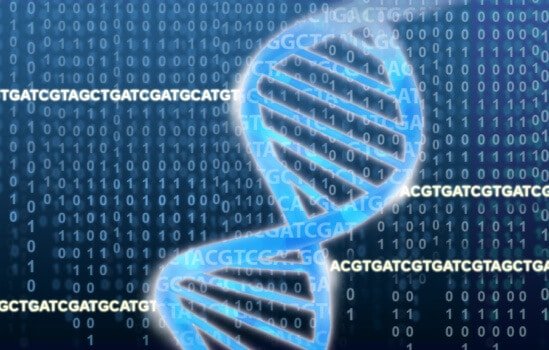Miriam Konkel has helped unravel the genomes of many animals, including the platypus, the rhesus macaque, the gibbon, the orangutan, the zebra finch and the marmoset. She also worked on the 1000 Genomes Project, which investigated the genetic diversity of humans. But a recent study of the baboon genome had a particularly exciting finding for the Clemson University researcher’s specific interest: Alu elements, a type of transposable element also known as jumping genes because they send copies of themselves to other locations in the genome.
Once considered junk DNA unworthy of serious study, Alu elements are gaining attention because they shed light on how genomes evolve. For instance, about two million years ago, baboons (in the genus Papio) started to differentiate into six distinct species, all of which exist today. Around the same time in the same region of sub-Saharan Africa, the genus Homo began to differentiate into several species; humans (Homo sapiens) are the only one that remains.
But while humans accumulated about 1,000 new Alu insertions per million years of evolution into their genome, baboons incorporated about four times that many.
“The degree of difference in the rate of insertions was surprising and new,” said Konkel, an assistant professor in the genetics and biochemistry department in Clemson University’s College of Science and a member of the Baboon Genome Consortium, which carried out the work.
“It means that Alu elements are more active in baboons,” Konkel said. “They create more insertions than in humans. There’s a higher potential for genetic diversity, and there’s also potential for downstream mutations.”

Miriam Konkel, assistant professor of genetics and biochemistry, said the surprisingly high rate of Alu elements in the baboon genome provides insight into genome evolution.
The baboon research, published in the journal Science Advances, was led by Dr. Jeffrey Rogers and colleagues at the Human Genome Sequencing Center at Baylor College of Medicine in Houston. Konkel, who has a medical degree from Germany and was a physician there, has worked extensively with this group since she was a faculty member at Louisiana State University, before coming to Clemson in 2017. Mark Batzer, who is also part of the Baboon Genome Consortium and an author on the paper, taught Konkel the craft of mobile element biology at LSU and co-led the mobile element analysis.
Early humans are known to have interbred with other Homo species, including Neanderthals and Denisovans. This new baboon research, the consortium said, provides unambiguous evidence that baboons are a good parallel case study for this evolutionary process. However, unlike the human case in which all other human relatives are now extinct, the ongoing interbreeding and genetic exchange among baboons can be directly observed today.
Baboon populations are widespread across sub-Saharan Africa. While studies of the behavior, morphology and ecology of these species lead to a detailed understanding of how baboons have thrived in different environments, the rise of the six baboon species and how the species became distinct from each other is less well understood.
“Baboons have long attracted scientific attention because they evolved within the same sub-Saharan African habitat in which early human ancestors arose. The behavioral and ecological differences among baboons make them an excellent model for investigating how a socially complex, highly adaptable primate lineage diversifies over time. In this new work, we show that baboon diversification and evolution was a more complex and reticulated process than was previously recognized,” said Jeffrey Rogers, associate professor in the Human Genome Sequencing Center at Baylor and lead author on the paper.
A reference genome for one baboon species, the olive baboon (Papio anubis), was generated and analyzed by a diverse group of scientists as part of the genome consortium. In addition, sequences from the other five baboon species within the genus Papio were also generated and compared to the baboon reference genome to compare and identify genetic differences across all six baboon species.
“We found that after new baboon lineages arose and differentiated, they did not remain completely isolated, but in fact have interbred, or hybridized, at several different times and places. This means that biologically significant genetic information was exchanged after the various species became recognizably distinct,” Rogers said. “Importantly, this process of hybridization and genetic exchange continues today, so that we and others can study the population processes involved in the evolutionary divergence that happens in the face of continuing gene flow.”
The researchers repeated the Alu analysis in the rhesus macaque genome, which diverged from baboons about eight million years ago, a similar timeframe to the separation between gorilla, human and chimp lineages. “This offers an interesting comparison for how things evolved in different lineages and a chance to see some of what happened there,” Konkel said.
The team found a high number of Alu elements specific to rhesus macaque as well, providing another interesting insight into evolutionary processes.
Baboons are widely used as a model species in biomedical research, providing important information about the underlying causes of and potential treatments for various human diseases. The genetic information gained through this genome sequencing study will be valuable to researchers using baboons to study various human health problems.
“The findings of this study are important in several ways. Not only are there novel understandings of baboon biology and an impact in evolutionary understanding, but also the application to biomedical disease research is apparent,” said Richard Gibbs, Wofford Cain Chair and professor and director of the Human Genome Sequencing Center at Baylor. “Baboons provide models for research in cardiovascular issues, such as hypertension and heart disease, as well as neurological conditions. Baboon research studies have contributed significantly to human health, and the better we understand the fundamental biology, the better we can make use of the information they provide.”


